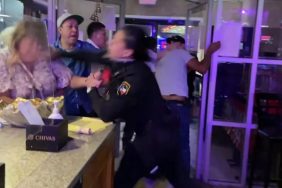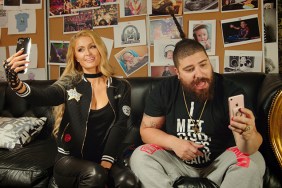What is the idea behind the cinematography of “Bullet in the Face” that’s all canted angles?
The tripod of the camera was broken, so that’s what happened. No, I think there was an intention to do a stylized fantasy look, a graphic novel look. A lot of times graphic novels have those tilted angles. It goes back further than the ‘80s, the original “Batman” series did something like that. So I think it was a nod to pretentiousness to do those Dutch angles as they’re called.
Everything was designed to try to give it a look and to give it a distinctive look that didn’t look like a comedy or standard TV on a low budget. It was also a desire to make it look like graphic novels which is something I certainly spoke about.
Can I download the “Bullet in the Face” theme song on iTunes?
Yes. That’s by Amanda Bauman. Everybody loves that theme. It’s a very catchy theme. She was somebody that kind of got launched from this so I’m thrilled about it. That’s on iTunes and it’s on Amazon and some other music sharing sites. You could also download it for free, but we don’t recommend that. Yes, you can get that song, “Theme to Bullet in the Face” which was always a nice title for a catchy theme to “Bullet in the Face.”
How did working with IFC compare to the broadcast networks?
Very different. Besides networks it’s also the era. That’s a whole long discussion certainly into itself.
If we had places like IFC and Comedy Central back on the ‘80s, could “Sledge Hammer” have had a home there?
I don’t know. “Sledge Hammer” was a network show. To this day it’s a bigger budget than what they are doing on cable and preferable for me to be a network show because it had a bigger reach. It had a much larger audience. In the day when it was considered a lower rated show it was still reaching 14-17 million viewers in the United States and then when it went global, obviously it reached even more people.
So the cable audiences comparatively are very, very small. What’s interesting is that a good rating on a cable channel could constitute disaster on a network. I used to make a comment about the difference between network and cable can be networks cancel shows that are flops that I’ve heard of and cable has hit shows that I’ve never heard of. It’s very, very different but the audience for IFC is very, very small.
If I got 17 million viewers on cable, they’d build an altar to me. That was considered a lower rating back in the time because we had “The Cosby Show” getting 40 million viewers. What was fascinating about what happened with “Sledge Hammer” is true of other cult shows. The mass exposure on a network stayed with people and carried with it decades later when it came on DVD and it sold so well. Everybody still remembered it and knew it because it had massive exposure at that time.
Well, you ruined David Rasche for me because I always recognize him. Even when he played a passenger in United 93, they were supposed to be using unknown character actors but he’s very known to me.
Oh yeah, and he’s able to be a chameleon and go back and forth but the cult people certainly react to him. He got applause when he showed up in Men in Black 3 and people called out, “Trust me, I know what I’m doing.” The same in Burn After Reading. So I’m thrilled for him that he’s able to be in those movies, those mainstream movies but the cult audience still follows him and it’s kind of an inside joke.
Edgar Wright told me that whenever David Rasche’s in a movie he calls out, “There’s Sledge!” Listen, that’s a blessing and a curse from being a cult figure when you’re associated with a character so strongly. It’s something Anthony Perkins said back in the day, “It’s so hard for an actor to be known for any character and have any cachet.” So he basically accepted that it was better to be known as Norman Bates because it was such a great part than not to be known for anything, and I think his mother agreed with that.









